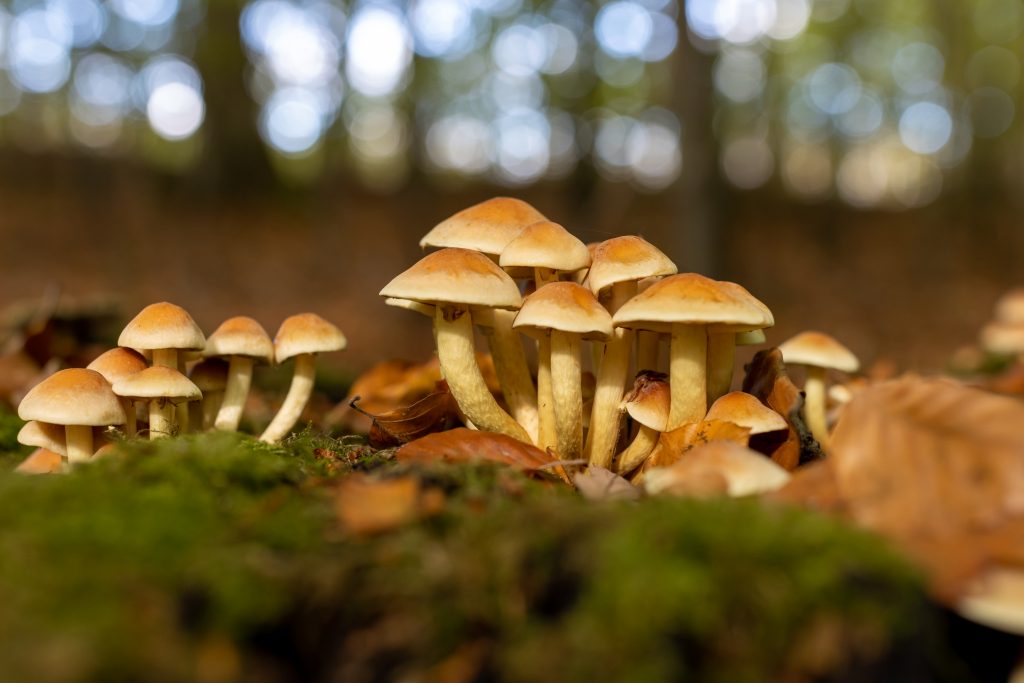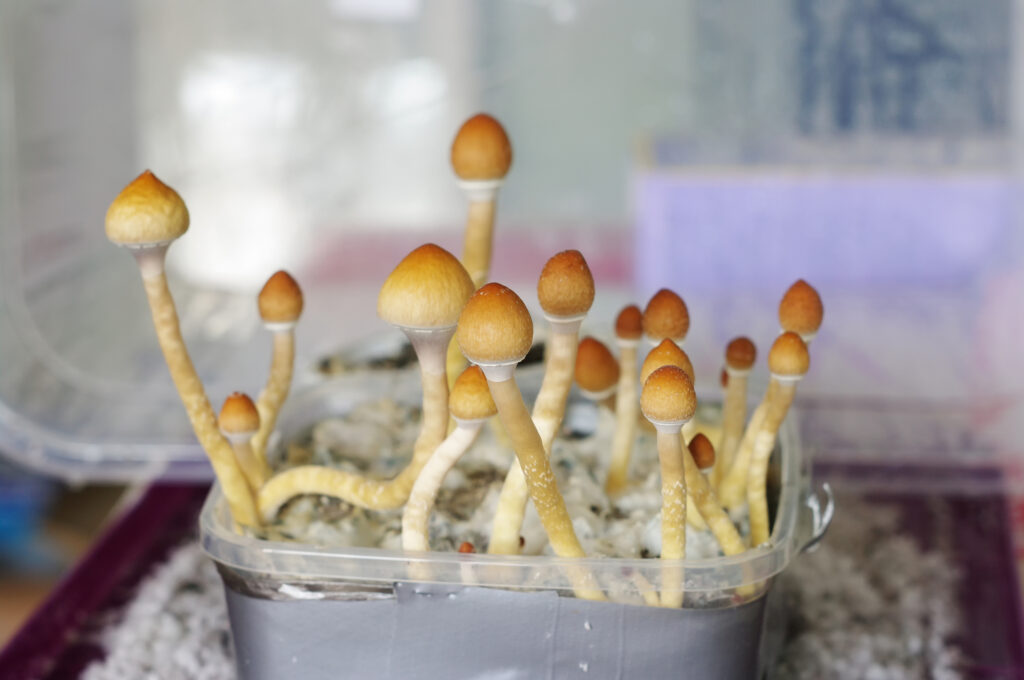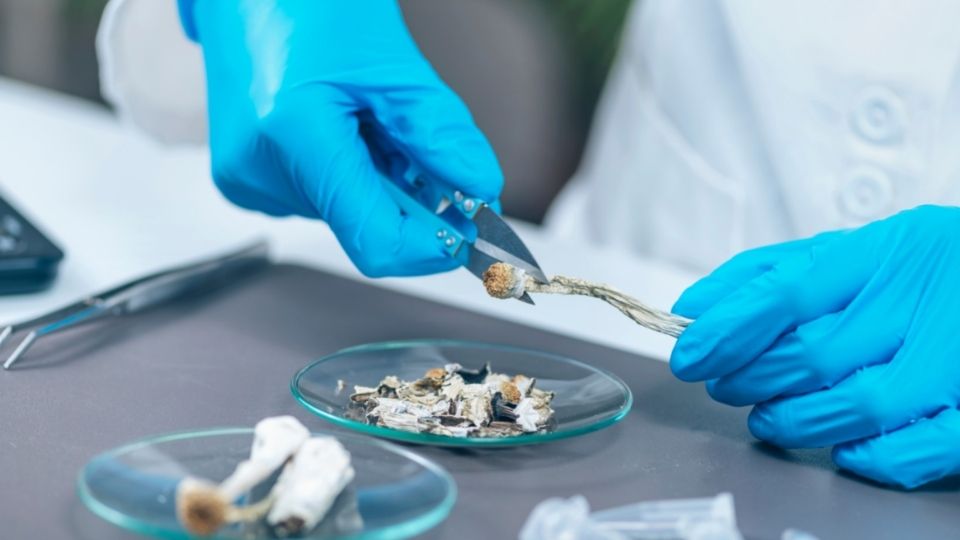You’ve probably seen mushrooms outside, you may have seen them at the grocery store and cooked them with dinner, and chances are you’ve heard the phrase “magic mushrooms.” But where do mushrooms grow? How do they grow? How do you plant mushrooms? We’re here to introduce the science behind growing mushrooms and to demystify fungi.

Where do Mushrooms Grow?
The short answer? In the wild, and in nature. The longer answer? In labs. On farms. In gardens. Or in your house, if you plant mushrooms. Really anywhere that’s warm, dark, and a bit humid. In fact, two-thirds of the edible mushrooms sold in the United States come from Pennsylvania, the majority are farmed near a town called Kennett Square.
Mushrooms are fungi and not a plant. Unlike plants, fungi don’t contain chlorophyll. They are considered microorganisms, and may even be closer related to animals than plants. Fungi survive on dead or decaying organic matter, often in the form of trees or other plants. There are many species of edible mushrooms, but also many poison mushrooms, and of course magic mushrooms. Magic mushrooms are magic due to psilocybin, a naturally occurring psychedelic found in over 200 species of fungi.
How to Grow Mushrooms
While the science behind growing mushrooms is different than taking care of house plants, we’ll start with some comparisons. Mushroom spores are the mushroom equivalent of a seed. In the wild, mature mushrooms spread their spores on the ground, fruiting more mushrooms.
A substrate for mushrooms is soil for house plants. But unlike plants, fungi cannot photosynthesize. They need to get their nutrients from the substrate with grown in. There are many different varieties and materials to make substrate for mushrooms including coffee grounds, straw, wood pellets, or even cardboard.
Where plants have root systems, mushrooms have mycelium. Mycelium are fine, thread-like filaments of tissue. Similar to a root system, mycelium extends into the environment (logs, trees, soil, plant matter) to gather nutrients needed for the mushroom to thrive.

Supplies You’ll Need
The science behind growing mushrooms can be the start of a new hobby. Just keep in mind, if you want to start planting mushrooms at home, that cultivating magic mushrooms from psilocybin spores is illegal. Some areas such as Denver, Colorado; Oakland, and Santa Cruz, California, as well as Ann Arbor, Michigan, have decriminalized growing magic mushrooms at home, selling and even possessing psilocybin. For the majority of states, all but Georgia, Idaho, and the rest of California, possessing psilocybin spores strictly for microscopy and research is perfectly legal.
Growing other varieties of mushrooms that contain no psilocybin is allowed all across the country. If you want to begin planting mushrooms of any variety, you’ll need to gather some supplies.
Spores: You can grow mushrooms from spores or mushroom spawn. Spawn is any material that already contains mycelium. While there are a variety of places to purchase spores, we definitely recommend our own collection. Whether you’re looking for Texas Ghost Spores or Penis Envy, Top Mushroom Spores can help.
Substrate: As we mentioned, a substrate for mushrooms fills the same role as soil for plants. You can find a variety of substrate recipes to create your own or buy some premade. Substrates should contain a small amount of magnesium, potassium, calcium, sulfur, and phosphorus. They should also be slightly acidic, and contain 50-70% moisture. A substrate for mushrooms should be sterilized to ensure no other organisms are competing for nutrients.
A container: This can be a plastic bag, a glass jar, a bucket, or a variety of other materials. For beginners, starting with a bag or a jar will probably be easiest.
A dark environment: Mushroom spores need a dark environment to incubate. Ensure you have a space, ideally not next to a large window or in a sunroom, where you can grow your mushrooms.

The Lifecycle of a Mushroom
The ideal way to grow mushrooms at home is to mimic the natural environment. The lifecycle of
a mushroom is broken down into four main parts: inoculation, incubation, fruiting, and harvesting. You can use plastic bags, mason jars, or even plastic boxes to grow your mushrooms.
Inoculation – Create your substrate. This can be a mix of common household materials such as coffee grounds or cardboard, or something more specialized such as vermiculite. The substrate should be moist. Add your spores by layering them into the substrate. Ensure there is some space at the top of your container to allow proper air, but keep it sealed.
Incubation – Putting your substrate in a warm dark place. Incubation can take anywhere from a few weeks to a few months depending on your species of mushroom. Magic mushrooms average a couple of weeks. Once your substrate is completely colonized with bright white mycelium, that’s when the incubation process is complete.
Fruiting – Once the incubation phase is done, it’s time to begin fruiting your mushrooms. The key is to expose your substrate and spore mixture to air. You can do this by cutting the bag or removing the lid of a bucket or container. Mushrooms need humidity and some light, but not as much as plants. A windowsill and the occasional spray with a water bottle are enough.
Harvesting – Finally, your mushrooms are ready to harvest. The harvesting timeline depends on the variety of mushrooms you’re growing. Generally, for magic mushrooms, the whole growing process takes four to six weeks. As long as the mycelium is still healthy, more mushrooms can continue to grow after you begin to harvest.
Growing mushrooms can be a fun hobby. There is a lot of science behind growing mushrooms, and your planting mushroom skills will grow with experience. If cultivating magic mushrooms is not legal in your state, you can still start your mushroom journey by studying some spores through microscopy and taxonomy. You’ll probably make some common mistakes, but soon enough you’ll be able to answer the question “Where do mushrooms grow?” with “My house!”